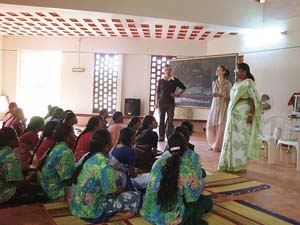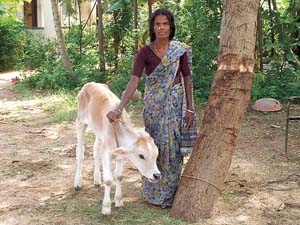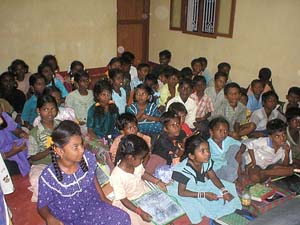Ocean Newsletter
No.154 January 5, 2007
-
Development for a New World Maritime Community
Yohei Sasakawa Honorary Chair, International Association of Maritime Universities (IAMU) Chairman, The Nippon Foundation / Selected Papers No.10(p.7)
Along with the globalization of the world economy, there has been a rapid internationalization and multi-nationalization of maritime activities. It is against this background that we must now undertake needed reforms of maritime society in order to realize coexistence between the ocean and mankind and to deal with emerging ocean problems. The development of superior human resources is the first step on the way to this new maritime society.
Selected Papers No.10(p.7) -
A New Era in Human Infrastructure of Marine Transportation - ILO Adopts Maritime Labour Convention, 2006 -
Tamaki Murakami Director of Seafarers Policy Division, Maritime Bureau, Ministry of Land, Infrastructure and Transport
In line with the world economy, global marine transportation including Japan's has expanded rapidly and the training of human infrastructure, that is, seafarers (maritime experts) calls for urgent attention.Through the newly adopted Maritime Labour Convention, 2006, it is necessary to enhance the seafarers labor standards, establish a world standard, and the secure good seafarers.
-
The Eco-Villages Project in Coastal South India: An Initiative of the International Ocean Institute
R. Rajagopalan Member, Governing Board, International Ocean Institute / Selected Papers No.10(p.10)
IOI, a global NGO, was established in 1972 by the late Professor Elisabeth Mann Borgese. In 1996, IOI decided to begin addressing the problems of the poorer coastal communities. The first project was in India. This article introduces our mission and accomplishments.
Selected Papers No.10(p.10)
The Eco-Villages Project in Coastal South India: An Initiative of the International Ocean Institute
The Beginning
I first visited Tiruchendur and the surrounding villages in 1996. I was then a Professor at the Indian Institute of Technology Madras (IITM) in the city of Chennai. I was also the Director of the Operational Centre of the International Ocean Institute (IOI), located at IITM.
IOI, a global NGO, was established in 1972 by Professor Elizabeth Mann Borgese. IOI works for the peaceful and sustainable use of the ocean and the coastal space, as well as the welfare of coastal communities. The IOI Network consists of 25 operational centres across the world and a headquarters in Malta.
In 1996, IOI decided to begin addressing the problems of the poorer coastal communities. The first project was to be in India and I was looking for a deserving target group and a reliable local NGO to implement the project. I found both in the Tiruchendur area. This is a small coastal town on the southeastern part of India, famous for its Hindu temple.
Coastal community
When we talk of the problems of coastal communities, we generally refer to fisherfolk and their difficulties. In India, fisherfolk are well organized and are able to fight for their causes. However, there are many non-fishing communities on the coast whose problems are more serious than those of the fisherfolk. Our project concerns one such community.
The IOI India Project villages are inhabited by dalits (meaning oppressed) who are at the bottom of the social hierarchy and who were considered untouchable until the time of India's independence. About 45 per cent of the population lives below the poverty line, with an income of less than US$10 per month. The unemployment level is about 50 per cent.
Being landless, the people only find irregular employment as masons or agricultural labourers. In some of the villages, the people collect seashells that are washed ashore and convert them into lime. Many of the women work as domestic servants in the richer households of the area. The dalits are normally not allowed to take up fishing. However, in one or two villages right on the coast, some of the people do limited fishing.
Women and children in these villages are under particular stress. The women have to manage the household, care for the children, collect water and firewood and also work for low wages. Besides, most of them have to deal with alcoholic husbands. Most of the children go to the government schools, which are in poor condition. In addition, these children also face social discrimination at school. Many children, especially girls, drop out of school before reaching the 10th grade. Many young boys move to cities only to find low-paid work under harsh conditions.
The area suffers from an acute scarcity of drinking water. The traditional ponds and wells are dry and the supply of water through public taps is erratic. The ground water has also turned saline in many villages. The area gets about 600 mm of rain, but this rain occurs over a short period of time and all the water disappears within a month or two.
Collecting water and firewood is a major occupation of the women taking up a considerable amount of their time and energy. They use traditional wood-burning stoves which are not fuel-efficient and which give out smoke, which is hazardous to health. Over the years the green cover in the area has been depleted and yet there is widespread cutting of the few existing trees.
A local NGO, Anawim Trust, had been formed in 1993 by a group of concerned individuals and its target group was these socially and economically disadvantaged communities near Tiruchendur. By 1996, Anawim was active in about 10 of these villages, promoting women's self-help groups and vocational training.
First visit and first impressions
Sometime in October 1996, I took the Pearl City Express from Chennai to Tuticorin, a journey of about 16 hours. The port city of Tuticorin is called Pearl City, because natural pearls were once abundant in this part of the coast. Now, of course, all the pearls are gone, and the only reminder is the ugly and large cement pearl that greets you when you get out of the Tuticorin railway station. From Tuticorin, I took a cab to Tiruchendur, an hour's drive.
Having been an academic and an urbanite for the most part of my life, I had no idea of rural development. However, soon after visiting a few villages and talking to the Mr.Sekhar, the Founder-President of Anawim, two things became clear to me: the people were in dire need of help and Anawim was an extraordinary NGO totally committed to the advancement of the villagers. I had earlier seen equally deserving target groups on the western coast of India, but I had been badly let down by the local NGOs through whom I wanted to implement the projects.
Objectives of the project



Anawim's goal has always been to support the empowerment of the communities, so that they can exercise their rights, have increased access to natural resources, and thus have greater control over their lives and livelihoods.
The specific objectives of the IOI-Anawim projects included the following:
- Enhancement the socio-economic status of the target communities, especially that of women and children.
- Creation of awareness among the coastal communities, especially women and children, regarding coastal ecology and the importance of preserving the natural environment.
- Preservation and restoration of coastal ecology through community action (measures like increasing the green cover, conservation of local biodiversity, rainwater harvesting, conservation of water sources, etc.)
- Testing and promotion of ecotechnologies like rainwater harvesting, increasing green cover, promotion of fuel-efficient stoves, use of solar energy, spirulina production, etc.
- Integration of environmental conservation and livelihood issues of the people.
We called our effort as the Eco-villages Project to imply that environmental conservation will be central to all our activities.
From 1997 to 2003, it was a roller-coaster ride for me. I was always busy writing funding proposals, dealing with donors, making detailed plans of activities for Anawim, monitoring the projects, preparing reports, disseminating the experience to the other IOI Centres, and at conferences, etc. I was constantly looking for new ideas as well as opportunities for learning from other organizations. I made it a point to visit the villages at least once a month for three days.
Every proposal faced uncertainty and yet funds kept coming. From 10 villages we expanded our work to 60. Those were heady days, but my mood alternated between hope, satisfaction, and frustration. There was so much to be done and there were also many obstacles.
Achievements
Over the last ten years, the major achievements of the projects have been:
- Over 120 women's self-help groups have been formed in 60 villages and there are now over 2000 members in these groups.
- Over 600 toilets have been constructed in the villages providing immense relief to the women.
- A 7-acre organic farm has been set up near Tiruchendur and it includes:
- A training centre for conducting courses and meetings for women and children.
- A production centre for women for promoting small businesses like the manufacture of palm leaf products, soaps and whiteners, herbal medicines, spirulina, etc. It has in addition a small printing press.
- Herbal nursery
- Laboratory for testing spirulina
- A central library
- Over 2500 loans (US$40 to US$100) have been given to women for starting micro-enterprises.
- Evening schools have been established in 30 villages, catering to the needs of over 800 children. The children come to the centre in the evening for games, study and extra-curricular activities.
- Over 300 training programmes have been conducted for women and children accounting for a total of 16000 participant-days. The programmes included training in skills, development issues, vocations, and ecology.
- Children have been trained to conserve the biodiversity of the area and to plant and use herbal gardens.
- Over 55000 tree saplings were given to the villages with the women's groups taking responsibility for planting and taking care of them.
- Water conservation measures including rainwater harvesting have been initiated. Rainwater harvesting tanks of 10,000-litre capacity have been built in several villages and evening schools.
- Women and children have been trained to operate computers.
- Sports and cultural programmes have been conducted for women and children.
Tsunami relief and rehabilitation
Five of the villages were severely affected by the tsunami of December 2004. There was no loss of life, but many houses, boats, and limekilns were washed away. The waves also took away the entire collection of shells heaped on the shore. Since the tsunami, seashells have become scarce and fish catch has gone down.
Anawim and IOI provided immediate relief, but were more concerned about long-range rehabilitation of the community. In 2005, IOI was awarded a project by the UNDP Unit for South-South Cooperation for the rehabilitation in one of the affected villages. IOI and Anawim have used the funds to retrain the women in alternative occupations and to provide them with microcredit. This project has been given a special award by the South-South Unit.
Donors
For the projects, IOI India was able to raise funds from private donors and many other sources including the IOI Headquarters in Malta, Asha for Education of USA, Japan Fund for Global Environment, Keidanren Nature Conservation Fund and Aeon Foundation of Japan, and Ocean Science and Research Foundation, Switzerland.
Once the IOI projects started showing results, Anawim was also able to raise funds independently from sources such as the Japanese Consulate, Chennai.
Major problems and lessons learnt
- Human resource: Finding committed staff to implement the activities has always been a major problem. Often, trained people left us and those who stayed were not the best.
- Village cooperation: This is a mixed bag, each village being different. In some villages, the women's groups have been active, pitching in to help us move forward. In others, lack of unity, petty squabbles and ego clashes have caused great damage to the projects and to the villagers' wellbeing.
- Corpus fund: Given the conditions imposed by the donors and the intention of IOI and Anawim to make every rupee reach the people, Anawim could never put together a corpus fund to make its basic operations going. Even now, when projects end, there is no money to retain the services of good resource persons.
- The last mile: A large number of excellent ideas have been tried and many have shown very good results. However, projects have often ended before we could take an idea to its logical conclusion and ensure long-term sustainability.
Some soul searching
It was my great fortune that I landed in Tiruchendur in the course of my quest. Was Anawim equally fortunate because I decided to work through them? Perhaps yes, because they had run out of funds and their activities were in danger of being slowed down or closed.
Does the term Eco-villages fit the situation? Not really. No doubt, our activities have promoted eco-architecture, created greater environmental awareness, resulted in more trees and conserved some water. However, the villages are not really green with lush forests and flowing water.
Were the villagers fortunate because we brought projects to them? Time alone will provide an answer. After almost a decade of work, I would say that the projects have made some difference to many of them. I cannot, however, say that the people have become free of their social and economic deprivations. It is also not clear whether all the positive changes brought about by the projects will be sustained in the long run.
Perhaps I have got more out of the work than the people themselves. It has been a humbling and learning experience for me. I can truthfully say that my life has changed because of my involvement in the villages.
